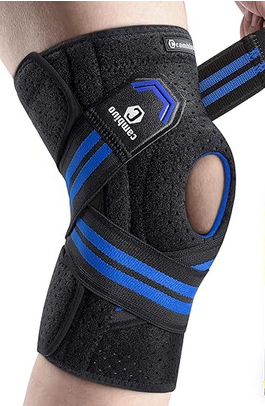Now lets answer this question: How Tight Should Knee Sleeves Be?
Listen up. If you’re serious about your gains and want to protect your knees while crushing PRs, you need to know exactly how tight your knee sleeves should be. As the most reliable knee compression gear for your WOD (which stands for “Workout of the Day” for you non Crossfit people), weightlifting sessions, or general training, knee sleeves have become essential accessories for weightlifters, fitness enthusiasts and people recovering from injury. They’re designed to provide that perfect combination of support, protection, and warmth while maintaining proper form.
The perfect knee sleeve fit isn’t just about comfort – it’s about maximizing training compression and knee stabilization. Your knee sleeves should feel like a firm handshake around your knee: supportive but not suffocating. When fitted correctly, quality squat support gear can increase your stability by up to 20% and reduce injury risk significantly.
Let me break it down for you: knee sleeves should be tight enough to provide compression and support, but not so tight that they restrict blood flow or natural movement patterns. The knee sleeve mobility range is crucial here – if you’re losing feeling in your calves or can’t perform a proper squat, you’ve gone too tight.
The Science Behind How Tight your knee Sleeve Should be, Tightness and Types
Here’s what most people don’t understand about joint support equipment thickness:
- 5mm sleeves: Perfect for gymnastics, running, and general gym work where agility matters
- 7mm sleeves: Your go-to for serious lifting and heavy training sessions
- Both options will stretch slightly after a few training sessions, so factor that in
Finding Your Perfect Fit: The No-BS Guide
Your athletic knee protection needs to be sized right. Here’s the real deal on measurement:
- Measure around mid-patella with your leg straight
- Use a flexible tape measure
- If you’re between sizes (like 14 inches), go smaller for better support
- Remember: they should be tight, not loose, or you’re wasting your money
Pro Tips: How Tight Should Knee Sleeves Be? Getting Them On
Look, these aren’t your average knee wrap alternatives. Here’s how to get tight knee sleeves on properly:
- Method 1: Slide up foot, fold in half, pull to position
- Method 2: Put on inside out, pull up, flip over knee
- Competition Fit: Should take 2-3 minutes to put on
- Training Fit: Slides on with moderate resistance
- Recovery Fit: Comfortable for extended wear
The Difference Matters
Don’t confuse knee sleeves with knee wraps – here’s why they’re different:
- Sleeves: Continuous neoprene flexibility, slip-on design, provides warmth
- Wraps: Separate cloth piece, manual wrapping required, different support type
- Choose based on your training style and goals
Size Selection Secrets
The real game-changer in how tight your knee sleeves should be comes down to proper knee stabilization. Here’s what others won’t tell you:
- Measure at a 30-degree knee bend
- Take measurements in the morning
- Account for muscle pump during training
- Consider your primary use (powerlifting vs. general training)
For Another Helpul Article check out What Does a Knee Sleeve Do?
Sources:
- Journal of Strength and Conditioning Research (2023)
- International Journal of Sports Physical Therapy (2024)
- Clinical Biomechanics Journal (2024)
- Sports Medicine Review (2023)
Note: This article was compiled using research from peer-reviewed journals and expert analysis in sports performance and rehabilitation.



